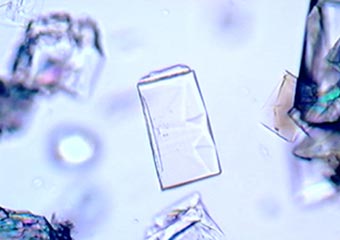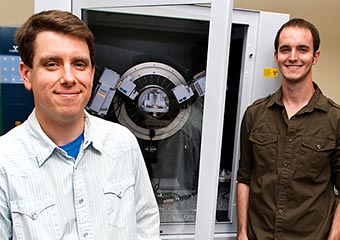Spotlight
Clean Breakthrough
| USF News

The metal-organic framework material shown under a microscope.
Photo courtesy of Mike Zaworotko

USF graduate students Patrick Nugent and Stephen Burd.
Photo by Aimee Blodgett | USF News

Chemistry Professor Mike Zaworotko.
Photo by Aimee Blodgett | USF News
Chemists at USF and King Abdullah University of Science and Technology (KAUST) have discovered a more efficient, less expensive and reusable material for carbon dioxide (CO2) capture and separation.
The breakthrough could have implications for a new generation of clean-air technologies and offers new tools for confronting the world’s challenges in controlling carbon.
The international group of scientists, whose research was published in March in the journal Nature, identified a previously underused material — known as SIFSIX-1-Cu — that offers a highly efficient mechanism for capturing CO2, even in the presence of water vapor.
That property, says USF Chemistry Professor Mike Zaworotko, makes it a promising candidate for real-world applications.
“I hate to use the word ‘unprecedented’ but we have something unprecedented,” Zaworotko says. “We sort of hit a sweet spot in terms of properties.”
The discovery further addresses the energy costs associated with the separation and purification of CO2 before it enters the atmosphere — costs expected to triple by 2050.
SIFSIX-1-Cu is a crystal whose atoms form a three-dimensional lattice with holes that snare molecules of CO2 but allow other molecules in air to pass. It more than 15 years ago, and is part of a general class of materials known as Metal-Organic Materials, or “MOMs.”
The breakthrough began with an undergraduate research project conducted by USF student Stephen Burd under Zaworotko’s supervision. Now a graduate student in chemistry, Burd’s initial testing of the material and discovery of its high-selectivity for CO2 grew to involve an international research group including USF chemists Brian Space, Shengqian Ma, Mohamed Eddaoudi (also a faculty member at KAUST) and graduate collaborator Patrick Nugent.
The research facilities at KAUST in Saudi Arabia combined with the multidisciplinary expertise in Eddaoudi’s research group allowed the design of unique experiments that permitted the sorption (the physical and chemical process by which substances attach to each other) properties of this class of materials to be unveiled.
The group believes the material has three potentially significant applications: carbon-capture for coal-burning energy plants; purification of methane in natural gas wells; and the advancement of clean-coal technology. Some 20 to 30 percent of the power output at a clean-coal plant is consumed by the cleaning process. The new material could make those plants more efficient and put more power into the grid, the scientists predict.
The next step is to collaborate with engineers to determine how the materials can be manufactured and implemented for real-world uses.